
Gas has been seen as a transitional fuel and an opportunity to make money. We now know that it is a major contributor to the climate crisis and should be seen as a planet wrecker. This calls for a reset of climate policy.
I go the long way around (sorry, we have 3,500 words in this one) but context is the most important factor in this reset.
Early in August 2021, when the latest IPCC AR6 had just been released, UN Secretary-General António Guterres called ‘Code Red for Humanity’. We had to give up on and close coal and gas immediately:
- We need immediate action on energy. Without deep carbon pollution cuts now, the 1.5°C goal will fall quickly out of reach. This report must sound a death knell for coal and fossil fuels, before they destroy our planet. There must be no new coal plants built after 2021. OECD countries must phase out existing coal by 2030, with all others following suit by 2040. Countries should also end all new fossil fuel exploration and production, and shift fossil-fuel subsidies into renewable energy.
Prior to that back in May 2021 the International Energy Agency (IEA) issued a report Net Zero by 2050: A Roadmap for the Global Energy Sector saying there can be no new coal, oil or gas projects if the global energy sector is to reach net zero emissions by 2050 so that catastrophic climate change might be avoided. The Climate Council highlighted the fact that the report:
- outlines how the transition to net zero can create 14 million new jobs by 2030, almost three times more than the jobs that will be lost as fossil fuels decline.
The Council’s own report of April 2021 “Aim High, Go Fast: Why Emissions Need to Plummet this Decade”, is an excellent piece of science communication.
In summary, they say the climate is already dangerous as we experience more powerful storms, destructive marine and land heatwaves, and a new age of megafires, floods and droughts. Evidence strongly suggests that global average temperature rise will exceed 1.5°C during the early 2030s.
If temperatures spike above 1.5°C for a significant period of time, critical ecosystems on which we depend (such as the Great Barrier Reef) would be even more severely damaged, or destroyed.
2050 is far to late to reach net zero. They recommend a 75% reduction of emissions by 2030, and net zero by 2035, not as an ideal, but probably the best we can manage.
- The world achieving net zero by 2050 is at least a decade too late and carries a strong risk of irreversible global climate disruption at levels inconsistent with maintaining well-functioning human societies.
They pay full attention to paleo-climate science noting that the last time we had CO2 at over 400 ppm was in the mid-Pliocene, when sea levels were about 20 metres higher than now. In geological terms human induced climate change is seen as hitting with a force only matched by the asteroid strike 66 million years ago causing the Cretaceous–Paleogene extinction event when three quarters of all plant and animal species met their end. In all IPCC scenarios 1.5°C is only achieved with overshoot and drawdown.
Tipping points
The significance of 1.5°C is said to be that it gives us a good chance of avoiding tipping points, a critical threshold that, when exceeded, leads to large and often irreversible changes in the state of the system.
Will Steffen, a world class climate scientist who looks at climate from an ‘Earth systems’ perspective, and is a councillor at the Climate Council gave a talk in April 2020 Climate Change 2020: Why we are facing an emergency. Central is this statement:
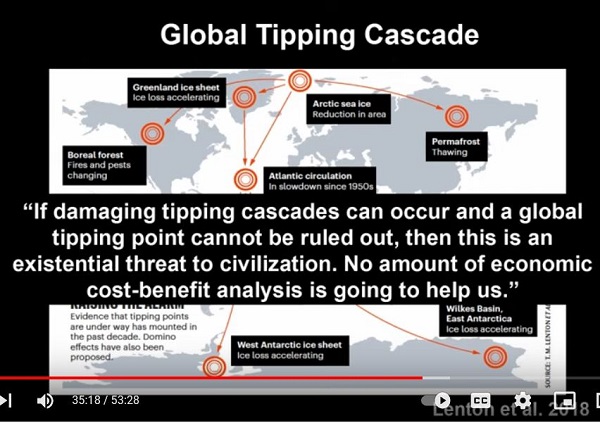
I’ll just repeat that text:
- “If damaging tipping cascades can occur and a global tipping point cannot be ruled out, then this is an existential threat to civilization. No amount of economic cost-benefit analysis is going to help us.”
Steffen had first shown a slide from a 2018 paper with 15 tipping points, many of them interacting with each other, hence “cascading”:
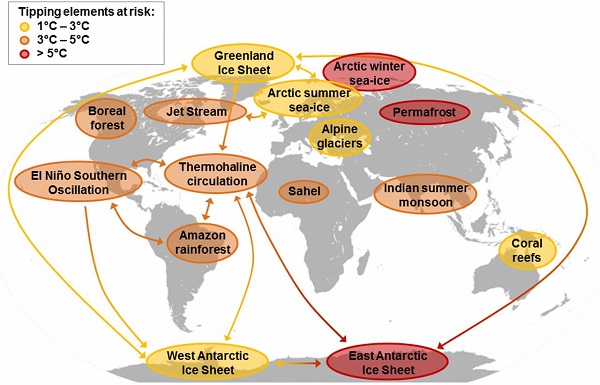
He followed that with a slide showing that all 15 were actually in play, then covered it with his stern message above.
Looking at the budget for burnable carbon, he says that for a 1.5°C landing point, we had five years from January 2018. Effectively it’s gone, he says, but we might just limit heating to 2°C if we go hard and go early. He said that 50% of the Great Barrier Reef is already gone. The one that really scares him is the slowdown of the Thermohaline circulation. That would bring cold and stormy weather to Europe, increase sea level rise in the US and in Antarctica, disrupt the Indian monsoon, quicken the drying of Amazon, while promoting the melting of Antarctica.
Worst of all, our realistic reaction time to prevent the worst of these is slower than the time when we would reasonably expect to reach such tipping points.
Except that we don’t know. We may already have passed the tipping points.
Our problem is that we act in human, political time, not in geologic time. He graphs the last 2000 years of temperature rise, plus the IPCC scenarios to 2100 like this:
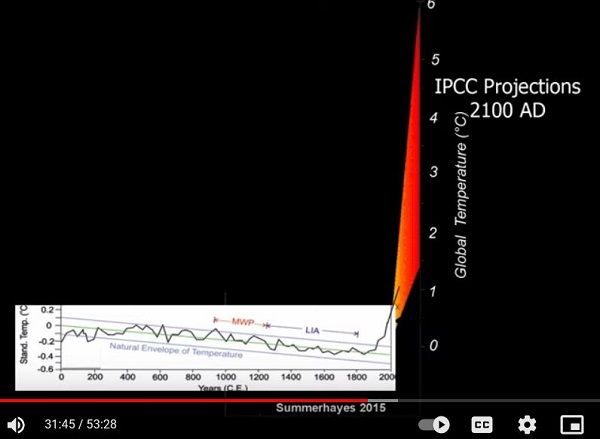
In Earth system terms we are slamming the ecology into a wall. On rates of change he says this:
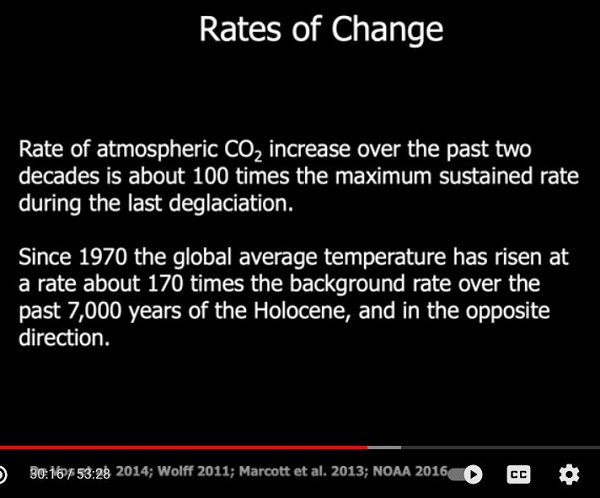
There has been nothing like it in the history of the planet. He thinks it is worse than the asteroid strike of 66 million years ago.
Rectification requires similar rapid and urgent action. Delay is not an option. Steffen shows us a graph from Christiana Figueres 2017 article (with some impressive scientific firepower as co-authors) Three years to safeguard our climate:
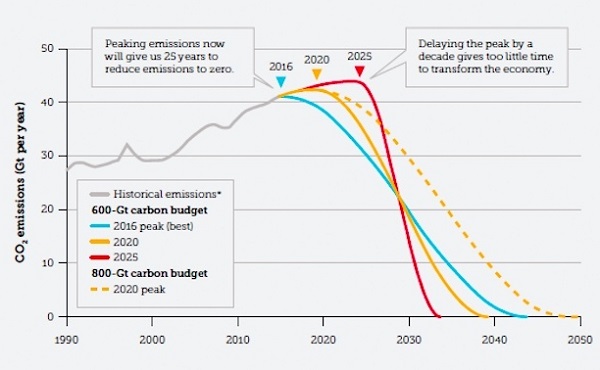
(I’ve borrowed the image from this useful site.)
That was April 2020, when emissions continued to climb, and kept climbing, regardless of COVID. Steffen’s body language showed, I think, that for him hope was draining.
That leaves me with two issues from what he said. First, the offer of stabilisation at 1.5°C or at 2°C does not inspire confidence. The graphic presentation is as follows:
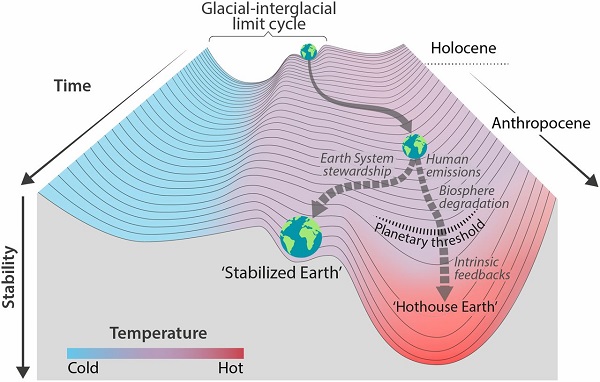
That image from the “Hothouse Earth” paper Trajectories of the Earth System in the Anthropocene leaves us teetering on a ledge which has no solid basis in science. The main thrust of the lecture is in fact that beyond 1°C the Earth System is inherently unstable.
Secondly, in a throw-away comment he tells us that he is only dealing with CO2. The assumption is that other greenhouse gases would be returned to pre-industrial levels.
Methane is worse than we thought
Traditionally CO2 was 80% of the Kyoto six GHGs, with methane accounting for most of the rest, making it responsible for about a fifth of the perverse GHG effect. The real relationship is complex as Gavin Schmidt’s The definitive CO2/CH4 comparison post last September revealed.
Methane as CH4 dissipates in the atmosphere to CO2 and H2O over 12 years. Initially, with indirect effects it is 125 times as potent as CO2. Traditionally the GWP (global warming potential) was calculated over 100 years. The IPCC now gives GWP-100 as 30 and GWP-20 as 83, the latter being highly relevant to decarbonisation in the context of the climate emergency, as the greenhouse impact of methane between now and the 2030 target date is huge.
The IPCC gives this graph to show the effect of methane on the climate since preindustrial times:
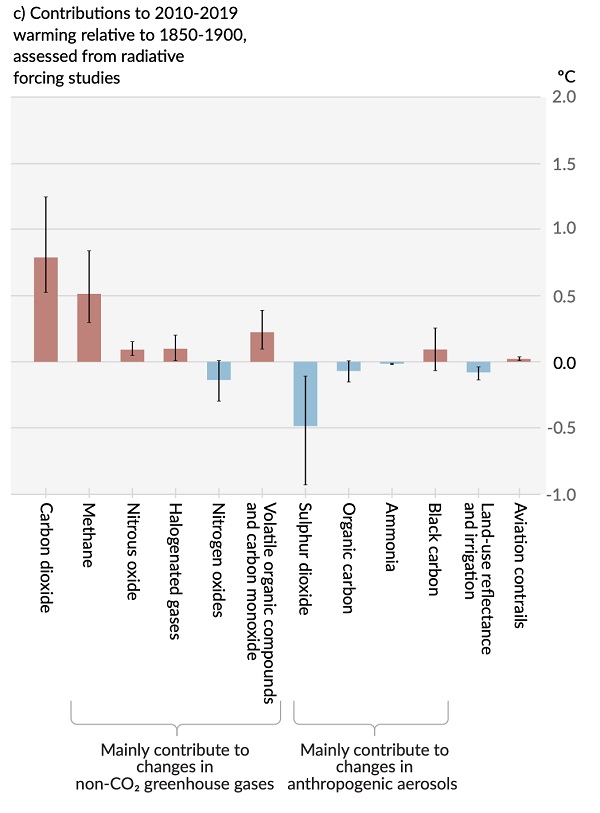
Roughly speaking if the temperature has risen by 1.25°C then 0.75°C was from CO2 and 0.5°C from methane. That makes methane up to 40% of the whole warming effect.
While CO2 has risen about 50% methane has tripled. Here’s how it is trending:
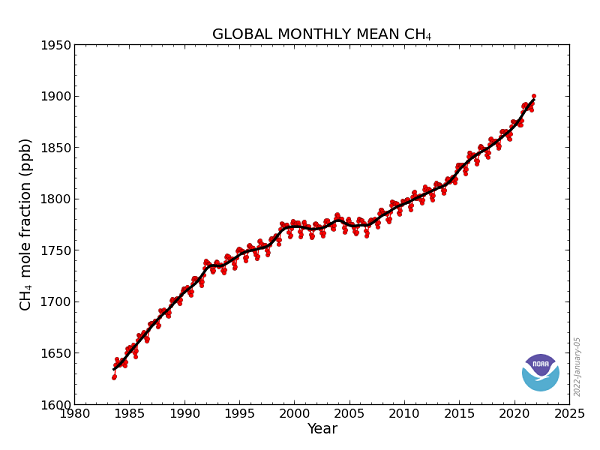
No attempt has been made in Schmidt’s post to distinguish between the sources of methane, and no comparison is made between burning coal vs methane for power generation. Many politicians believe gas is about half as damaging as coal. If we read the ABC RMIT factcheck Adam Bandt says gas is just as dirty as coal. Is he correct? we find the topic is complex.
Johnathon Mingle’s 2019 article The Methane Detectives: On the Trail of a Global Warming Mystery wrestles with the uncertainties about where the increased methane emissions are coming from and the astonishing lack of measurement of actual ‘fugitive emissions’ in the production and distribution of gas.
We know that a modern gas plant is about 60% as dirty as a modern coal plant. However, this has limited relevance because if fugitive emissions exceed 4% of gas produced it becomes dirtier than coal. The common range appears to be 3 to 7% but it can be as high as 30%.
Seems no-one is measuring leaks from pipelines.
For unconventional gas (coal seam and shale) I have not seen a thorough examination of the Scope 2 emissions involved in contributing operations, for example, establishing the infrastructure, fracking, cleaning and dealing with the contaminated slurry that brings up the gas. Then if exported the energy required to liquefy gas is considerable.
A new study has found satellite evidence of intermittent ultra-leakers from gas and oil production activities, not counted in the statistics.
Now it has also been found that gas in couplings and fittings leak 24/7 in homes, and that new gas stoves leak as much in lighting and burning as old ones do.
New gas is more expensive than renewables so I would agree with The Climate Council’s COVID recovery report when they say
- Gas has no role to play in building a prosperous, resilient economy for the future. It is volatile, dangerous and unnecessary.
Gas investments are likely to become expensive stranded assets.
Moreover:
- Emissions from the extraction, processing and export of gas have been the main driver behind Australia’s emissions staying so high. These emissions are likely underestimated.
See also their explainer Why is gas bad for climate change and energy prices?
Clearly we should be strenuously minimising the use of gas. Everything we do or don’t do in this regard matters.
So, what are we doing?
The Australian Government Chief Economist has put out a helpful report Resources and Energy Major Projects 2021 Report (pdf). Here’s the summary graphic, which I’ve divided into two parts to provide legibility. First the value of projects:
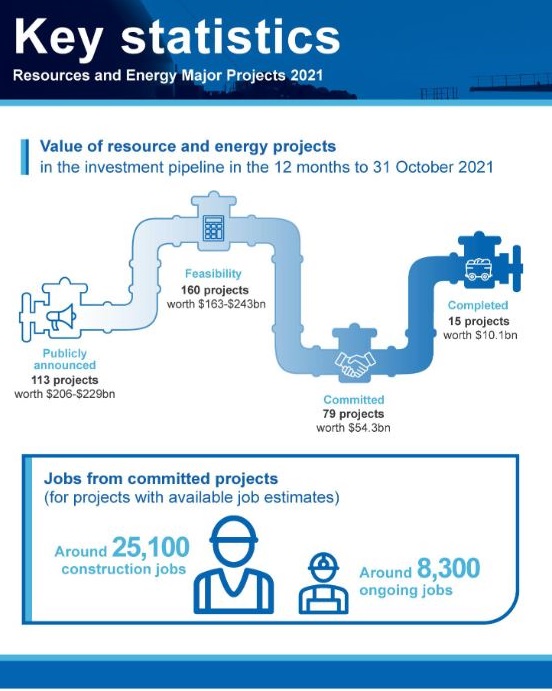
Second, the share of committed projects by commodity:
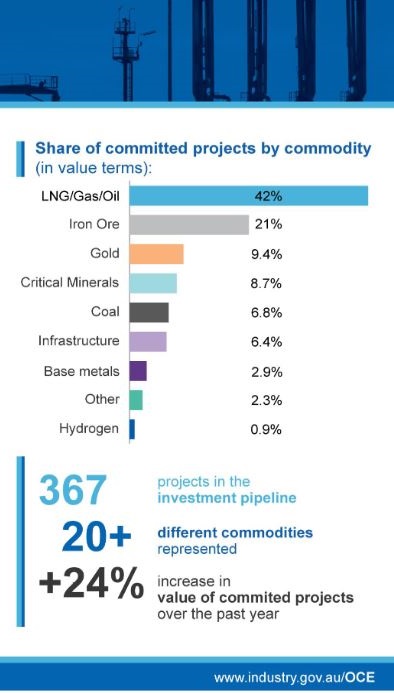
Table 1.2 tells us that there were 69 coal projects announced, being assessed for feasibility, committed or completed as at 31 October 2021 with a value of $72-82 billion. There were 45 gas, LNG or oil projects worth $187-205 billion.
Two weeks after the COP26 Glasgow Climate Pact to move away from fossil fuels, the Government released a plan to drastically scale up gas projects nation-wide. Consulting firm Allens has a helpful explainer for capitalists wanting to get in on the act.
This map shows the scale of the plan to build pipeline infrastructure:
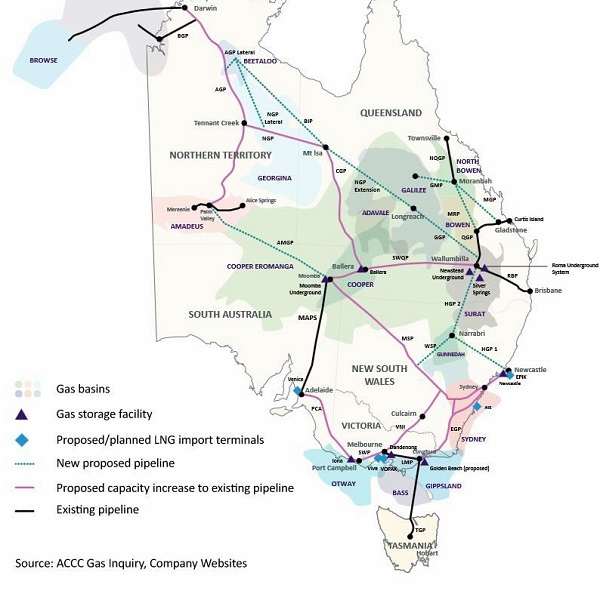
- The science is very clear: to avoid a climate catastrophe, fossil fuels must stay in the ground.
Instead of getting out of gas ASAP, as agreed in Glasgow at COP 26, we are in fact going gangbusters for it.
Climate Councillor Greg Bourne added:
- “It is abundantly clear that the Morrison government’s net zero by 2050 commitment was designed to mislead and always included expansion of gas.
“The International Energy Agency has made it very clear that there can be no new coal, oil and gas fields if we are to limit temperature increases to below the critical threshold of 1.5 degrees.”
(Emphasis added)Prof Euan Nisbet in Methane in the atmosphere is at an all-time high – here’s what it means for climate change has just given a timely roundup of where we are with methane, pointing out that at COP 26 in Glasgow more than 100 nations signed the Global Methane Pledge, promising to cut methane emissions 30% by 2030.
Large emitters, including China, India, Russia, Qatar and Australia, did not join.
Much of the methane surge comes from biogenic sources – tropical swamps and wetlands, bogs in the tundra – rather than fossil fuels directly, but it looks like a case of feedback, ie. fossil warming causing more biogenic activity causing more warming.
Towards policy reset
All that being said, it is not for me to tell policymakers what they should do. The real world is complex, not susceptible to simplistic solutions. There is momentum in the system.
In August 2021 the ACCC released its latest gas report with the headline Looming gas supply shortfall for east coast market:
- A supply shortfall in Australia’s east coast gas market is increasingly likely, especially in the southern states, the ACCC’s latest gas report reveals.
The report, released today, reveals a finely balanced supply outlook for 2022. A shortfall of 2 PJ could arise across the entire east coast gas market next year, driven by a shortfall of up to 6 PJ in the southern states, if LNG producers export all of their surplus gas.
This forecast is dependent upon demand from gas powered generators decreasing to record lows, and a material volume of gas from currently undeveloped reserves being supplied.
The basic problem is that gas resources in the southeast of the continent are running down. New coal seam gas in Queensland has to go the long way, through the gas hubs of Wallumbilla near Roma and then Moomba in northern SA to get to Sydney. New large potential gas sources are further north in Queensland, and especially towards central Australia and the Beetaloo Basin 500km from Darwin.
The new grand National Gas Infrastructure Plan 2021 is meant to fix that with new and enlarged pipelines. The Gas Fired Recovery Plan was to unlock supply, provide efficient transportation and empower consumers, whatever that meant.
The new gas is all unconventional gas, disruptive of landscapes, problematic for aquifers, expensive at the well-head and more. Santos’ Narribri Project with capacity to provide half NSW consumption has been approved by the Independent Planning Commission in spite of objections from farmers and the Environmental Defenders Office. Clearly the NSW Government was opposed, and a legal appeal failed.
It seems Lock the Gate’s compelling new groundwater evidence arrived too late. Further approvals have to be obtained on groundwater, so I don’t know how that will go. The latest (21 January, 2022) is that Santos have a clear runway to proceed, although campaigners will not give up, and the pipeline to bring the gas to market is bitterly opposed.
That was from Angela MacDonald-Smith in the AFR, who tells us (25 January) that in 2022 oil and gas explorers are honing their bits. The world only discovered 4.7 billion barrels equivalent in 2021, after 12.5 billion the year before. They are expecting a ‘better’ year.
In Australia the main focus will be:
- EnergyQuest CEO Graeme Bethune said the onshore Perth Basin is also “about to get a second wind”, with companies including Mitsui, Mineral Resources and Strike Energy all planning wells.
“Key plays to watch include horizontal flow test results in the onshore Beetaloo, Dorado satellites Apus and Pavo offshore Carnarvon Basin, and several Perth basin wells including South Erregulla and Lockyer Deep,” Credit Suisse’s Mr Kavonic said.
In South Australia, Beach Energy is gearing up for its first oil exploration campaign in the Cooper Basin’s western flank since 2017, with 12 wells committed to start in February.
There was no mention of the Cooper Basin’s eastern flank, where Santos and Origin hold exploration tenements in the Channel Country. I understand that further specific environmental approvals would be necessary from the state government before any work could begin.
Of interest, (see Bumps in road towards Beetaloo gas) at Beetaloo two test wells have achieved normalised rates of 2.5 million and 2.6 million cubic feet per day. One study deemed 3 million cubic feet per day as the threshold for commercialisation. Drilling is being subsidised by the public purse, but infrastructure and markets will need to be lined up before companies make a decision to proceed.
For further context, here are some selected graphs from the official Australian Energy Update 2021, which cuts and chops the energy statistics every which way. First, the Australian natural gas flow for 2019-20 in petajoules:
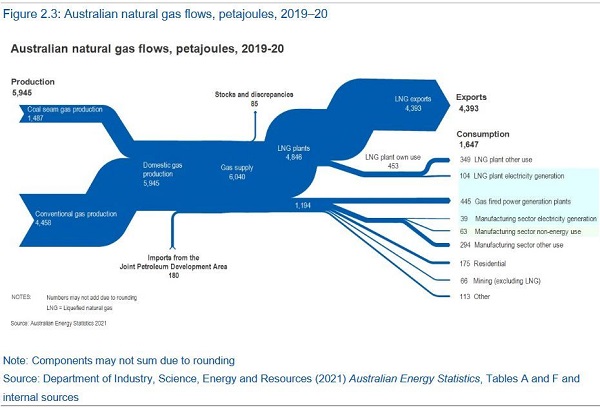
Hard to read, but we exported 4,393PJ and consumed 1,647.
Power generation used 445PJ, less than the 453 used on LNG own plants. Manufacturing used 396 in all, and 175 went to residences, presumably for heating.
This table shows increases in energy production by fuel type:
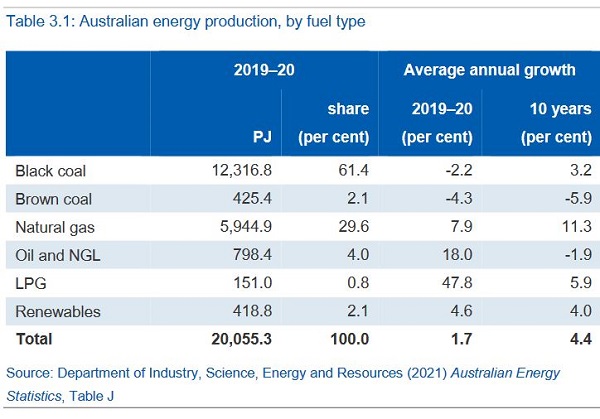
Here’s a graph of the trend:
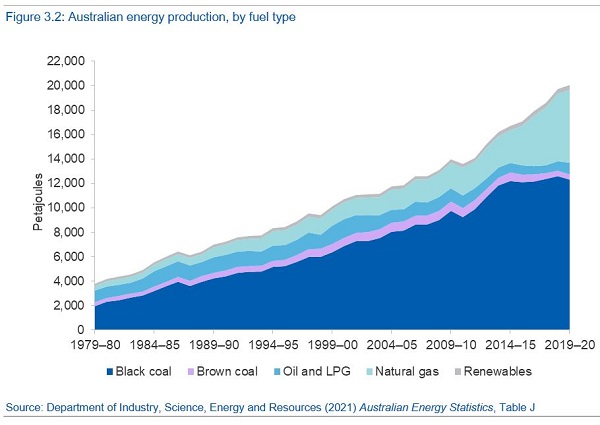
That frightened me. Some of us tend to live in that grey sliver representing renewable energy, unaware of what is going on around us.
This graph is from broker research on one of our listed gas majors:
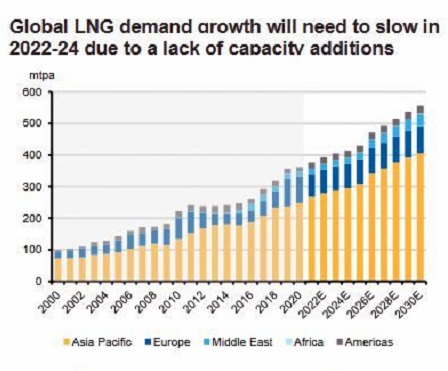
Some of our mining majors have sold their ‘dirty’ operations, but they don’t sell to entities which will close them down, rather to entities that don’t have brand awareness. Or there is a new name created.
BHP have merged their oil and gas portfolio with Woodside, where under the Woodside brand they will own 52% of the business.
Santos’ $22 billion merger with Oil Search (last December) under the Santos banner, has Santos claiming climate respectability on two grounds. First, gas is cleaner than coal.
Second, they are promoting ‘carbon capture and storage’ capability on the basis of what they have done at Moomba to extract more gas. I think the plan is to capture CO2 from the air (expensive, but possible) and inject it into the space vacated by mining gas to offer carbon offsets on the market. We are talking trivial quantities of a few million tonnes per annum.
However, the merger makes them strong enough that they can probably finance new projects internally, without going to increasingly risk-averse markets.
Finally price. The Macdonald-Smith articles linked above say that Narrabri can deliver gas economically while the spot price for gas is $10 to $11 per gigajoule, which is was in January. It seems gas from Queensland is determined by export prices.
Currently world spot prices are an eye-popping “more than $US20 ($27.80) per gigajoule”. However, the price is expected to settle when politics in Europe settle because of the sheer volumes of gas expected to come onto the market. Indeed five different entities are hoping to develop LNG import terminals around the south-east coast amid warnings of shortages from the ACCC and AEMO, starting about mid-decade.
So what do we do?
Is anyone serious?
The EU is looking to deem gas “green” so that they can meet their climate commitments. On paper.
Biden in the US, four days after COP 26, auctioned off oil and gas drilling leases in Gulf of Mexico only to have them thrown out by a judge because of a “serious failing” and a “grave error”. The federal government agencies had not taken into account the effect on global heating and the climate. Nor had they considered what was happening in the rest of the world.
Grist saw the judgement as a blow to the Biden administration, Reuters saw it as a Biden win for the climate. They say the:
- administration was later forced into the sale after several drilling states successfully sued in federal court in Louisiana. They argued that U.S. law requires the federal government to hold auctions on a regular basis to enhance energy independence and generate revenue.
Biden, they say, had announced a suspension of all new lease sales pending a broad review of drilling’s impact on global warming after taking office. Probably it will end in the Supreme Court.
I wish the Biden administration luck. I think they’ll need it.
So here is what I would do, in general terms.
-
1. Defeat the current Coalsheviks who occupy the treasury benches. They will never give the climate crisis the proper priority.
2. On gaining office, conduct a broad review of the impact of our fossil fuel mining with respect to:
- (a) global heating and the climate crisis, and the need for social, economic and environmental sustainability
(b) the risk of stranded assets in existing and any new developments.
I don’t think we can continue to say that we will supply coal and gas while others say they need it, or leave the decisions to desist to boardrooms in foreign cities. We should only supply to counties and entities who are serious about mitigating the climate crisis.
Remembering
On the way out, remembering the following, inter alia.
Sir David told us in February 2021 that dangerous climate change was here already and that what we do in the next few years will determine the future of humanity.
If we carry on as we are new research suggests that more than two-thirds of the planet’s oceans will be deprived of enough oxygen by 2080 as a result of warming temperatures. That lack of oxygen will decimate fish stocks worldwide, likely leading to food shortages in many parts of the world.
New research shows global warming of 1.5C will be catastrophic for almost all coral reefs worldwide, even sites scientists once thought of as refuges – none of which are known in Australia.
David Spratt has the bad news on tipping points. We have triggered five, he says, with more to come. He reminds us that burning fossil fuels produces sulfate aerosols, which hide up to one degree of warming. He thinks we need active drawdowns and will have to consider active cooling.
Paul Gilding has written a post Why The Climate Emergency is now The Methane Emergency. As Alan Kohler predicted, it’s time to panic on climate action. Gilding thinks we are going to very soon realise that we have to take large-scale immediate action to ensure our survival. He’s working on a longer paper to tell us what we need to do.
Update:
Angela Macdonald-Smith in the AFR tells us that the new Kurri Kurri gas generator will generate 520 grams of CO2 per kilowatt-hour of power generated, which is nearly double the new EU “taxonomy” which has a limit of 270g/kWh.
Kurri Kurri is a “peaker” which will run about 2% of the time over a year, not a “closed-cycle” more commonly found in the EU.
Here’s how our plants stack up:
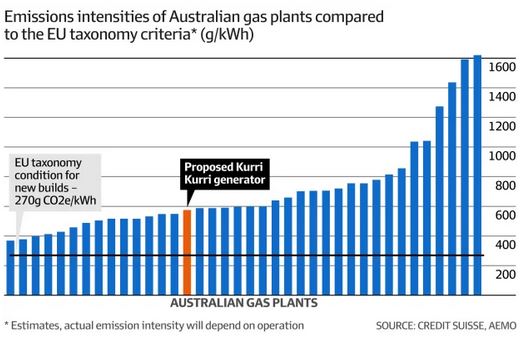
Our average is 700g/kWh compared with a world average of 495g/kWh.


Done!
That took a while. Kept finding new stuff and it’s easier to put stuff in than leave it out!
From Nicki Huntley:
Voters in coal and gas heartlands are ready to cash in on a clean energy future:
As the accelerating effects of climate change ravage swathes of our nation, a new poll has found voters from the coal and gas heartlands of New South Wales and Queensland are ready to cash in on the opportunities of a zero carbon emissions future.
The poll, released on Wednesday, reveals that the clear majority of voters believe the states’ future prosperity lies in clean industries, such as renewable energy exports, critical minerals like lithium and cobalt, and manufacturing renewable products.
Australia’s failure to cut emissions this decade will equate to tens of thousands of lost jobs.
Voters in both states have seen the writing on the wall: The era of coal and gas in this country is ending, with only a quarter of voters in Queensland and about one-fifth in NSW saying future prosperity lies in coal and gas.
Moreover, two-thirds of voters say clean jobs, for example in renewable energy, will be the best source of future employment.
Less than a quarter overall back fossil fuels as the best source of future jobs.
Significantly, they recognise that credible and ambitious climate action is good for business and employment.
About 58 per cent in Queensland and 64 per cent in NSW said further cuts to carbon emissions – essential if we are to keep global warming below 1.5 degrees Celsius – will increase jobs and boost the economy.
Brian: For what it is worth Milankovitch 100,000 yr cycle data is saying that the planet is due to start cooling now. Not sure what difference this will make.
JD A few more Tongaesque volcanos might dim the sunlight too.
Well, the scomo promise to boost gas is shaping up.
Gas for “clean” hydrogen
Now gas for power in the Hunter.
I used to own a business. We had a saying: We will bend over backward for our customers, but we won’t bend over forwards!
As a voter, I am being bent over forwards. So are my family and everyone else’s too.
Brian, I have not yet read your post, and you might have thrown in the idea that the melting permafrost is releasing huge amounts of methane. To that, we can add fugitive emissions and pipeline leaks.
First up, I’ve corrected the story about the fish to read as follows:
If we carry on as we are new research suggests that more than two-thirds of the planet’s oceans will be deprived of enough oxygen by 2080 as a result of warming temperatures. That lack of oxygen will decimate fish stocks worldwide, likely leading to food shortages in many parts of the world.
It was two thirds of the oceans, not all of them.
Worst will be the western North Pacific, North Atlantic, and Southern Oceans.
Geoff, the methane clathrates are one of about 15 tipping points. I think they are in the category of definitely in play, but we don’t know whether they have yet tipped. David Spratt took a look recently, and came up with this:
In conclusion: are permafrost and methane clathrates the “carbon bomb” that could drive the the “Hothouse Earth” scenario? Yes. Do we know that the feedbacks have already driven these systems to a tipping point? No. But when risks are existential, focus must be given to the high-end possibilities, and what needs to be done to prevent them being realised.
Gas leaks everywhere, including in the kitchen if you have a gas stove. It is definitely bad for your health if you do have it there.
John, we’ve been told more than once that the Milankovitch cycles have been cancelled by the Anthropocene. If you follow the links to Climate Reality Check 2021 with David Spratt et al:
The rate of rise in global temperature is
likely to speed up over the next 20-30 years
• The 2020 global temperature was 1.3°C warmer than the late19th century.
• The 5-year global average temperature for 2016-2020 was
1.2°C, according to NASA1 and Copernicus.
• Warming accelerated to~0.25°C for the most recent 2011-20 decade, compared to the average decadal rate of
warming over the previous 50 years of 0.18°C.
• Current (CMIP6) climate models project on average a warming of 0.3°C for the decade to 2030 (across the SSP2-4.5, SSP3-7.0 and SSP5-8.5 scenarios).
• The next 25 years are projected to warm at a rate of 0.25–0.35°C per decade; and there are warnings that the rate of global warming over the next 25 years could be double what it was in the previous 50 years.
John, if you go to Will Steffen’s talk I linked to, start about 20:25. About 10 minutes later he gives you the answer, based on this graph:
He says that without global warming the temperature would have flattened out for about 1,000 years, then started the slow dive into an ice age.
He says the rate of change of CO2 is 100 times now, and the temperature change is 170 times.
That’s what will give us a major extinction event, probably akin, in the end, to the Cretaceous–Paleogene extinction event which knocked over the dinosaurs.
Brian: Humanity is good at creating extinction events even without contribution humanity makes to the growth of atmospheric greenhouse gases.
An American startup is promising to make green steel a reality within the next three years, without hydrogen, coal or even a blast furnace.
Boston Metal employs a technology known as Molten Oxide Electrolysis (MOE), which uses renewable electricity to turn iron ore into liquefied metal.
I am assuming that they are talking about something aluminum smelting where the electrolysis takes place in a molten salt bath.
You can’t make green steel in a blast furnace because you need coke to provide the bed that allows gas to flow up and liquid metal and slag to flow down.
To me this is a blast from the past. I was interested in blast furnace operation and alternative steelmaking processes early in my career.
Thanks, John.
Gotta fly, but have done an update to the post:
Angela Macdonald-Smith in the AFR tells us that the new Kurri Kurri gas generator will generate 520 grams of CO2 per kilowatt-hour of power generated, which is nearly double the new EU “taxonomy” which has a limit of 270g/kWh.
Kurri Kurri is a “peaker” which will run about 2% of the time over a year, not a “closed-cycle” more commonly found in the EU.
Here’s how our plants stack up:
Our average is 700g/kWh compared with a world average of 495g/kWh.
By its nature fossil fueled peaking power is going to be more emission intensive than baseload power. However, in this day and age batteries would seem to make more sense than the Kurri proposal.
I’m still backing stored hydro. Some say it’s too expensive but the basic infrastructure – the storage and pipes will be around for decades after wind turbines are worn out and same with other systems. So your write off time for hydro is far greater.
That said, the exception could be Snowy 2
Geoff, I tend to agree about pumped hydro.
Snowy 2.0 was too big, the rock too hard, and it is too far away from the network. That’s just for starters. I think we would be further along if the Govt had subsidised a program of small projects all over the country. Andrew Blakers had done the work on site location.
John, I keep hearing of technical breakthroughs. One about fusion in the New Scientist just floated by my gaze.
On green steel, Tim Buckley talked to Phillip Adams in Can hydrogen be green and blue?
Buckley is not a technical person, but he says some of the biggest steel makers in the world, in Sweden, Germany and France, have now committed to green steel over the next decade.
He says it’s happening.
Renewables supplied five-times more electricity than gas generators in 2021
Just after I hit the “publish” button the other night I saw a short article in the AFR about Adam Bandt announcing the Greens’ climate policy.
One item was to have a moratorium on new coal and gas projects until the end of the year while we pause and consider.
Happens I agree with him. I’d just written 3,000+ words saying why. Adam has just told us in one sentence what he is going to make Labor do.
This has now been turned into an anti-Labor scare campaign, apparently with no mention of the Greens, see Coalition’s latest coal jobs scare campaign reveals a big renewables blindspot.
So now Bandt needs to put a bit of detail on why this extreme measure is necessary. Otherwise he is helping the Coalition at the expense of Labor in seats that the Greens will never (while I’m alive) win.
Thinking about pumped hydro, I wondered if there was a more efficient energy converter than a water turbine (^90%) and if piston pumps would be better. The answer is no. Pumping water up must be less efficient, but extracting the energy from the water looks like it is pretty damn good. Oil hydraulic systems are disappointing at just 70%. A chain drive is 97% efficient. It would be interesting to see the efficiency figures on hauling a tank of water up a slope would be. I suspect that the combination of frictions in the total system would the killer unless the lift and carriage mechanism was ball screws driving and driven by ball screws. https://monroeengineering.com/blog/pros-and-cons-of-using-ball-screws/
Then the thought of using springs to store energy. Looking up efficiencies and effectiveness there is a figure that springs can store .1 watt hours per kilogram , with the comment that springs are not suitable for storing energy.
I’m not so sure. .1 watt hours is not much at all, but 1 tonne of steel suitably configured should on the basis of the claim store 100 watt hours. So a one tonne mechanism sitting on the floor can store 100 watt hours at perhaps 90% efficiency.
Compare this to pumped hydro where one tonne of water with a 100 meter head stores 273 watt hours but the system is 70% to 80% efficient.
So it takes 3 tonne of steel to store the same energy as one cubic meter of water. But thinking about the spatial arrangement the 3 tonne of steel with the space it needs to take up as a machine would be around one cubic meter, the same space as one tonne of water, but the steel storage machine requires no more space for its operation, it just sits there doing its thing indefinitely, where as the one cubic meter of water needs to move backwards and forwards over a 100 meter distance.
This all makes Lithium Batteries look fabulous.
It would be interesting to examine how big a lithium recycling and battery building facility would be. A proper city energy scale Lithium based Energy storage facility should be self contained with a continuous recycling and rebuilding process built in.
Bilb: There have been a lot of proposals for storing energy over the years including many of the ones listed above.. Maybe some of them may be worth having another look at from time to time.
Brian: For federal elections the Greens will tend to run candidates in all electorates because it helps with the Senate vote.
Past experience indicates that an LNP candidate is more likely to be beaten if the Greens come second ahead of Labor. The reason is that a higher % of Labor voters give their key preferences to the Greens than vice versa.
The implication of the above may be that, in some seats it may be better if Labor didn’t run if the Greens put up a good candidate.
John, not going to happen.
To many in many electorates ‘green’ and ‘Greens’ is a pejorative scare word, like ‘unions’.
The Libs and Nats used to run against each other. Then they came to the agreement that they would only contest when a sitting member retired.
The Greens and Labor are a long way from being accustomed to being in coalition, and won’t get any closer with the current leadership. I think electoral reform with multi-seat electorates is key. Until that happens expect to hear me to keep complaining about the Greens strategy and putting politics ahead of principle.
Brian: “I think electoral reform with multi-seat electorates is key.” Even better if votes in parliament are weighted in terms of votes received after distribution of preferences. (Reduces the effect of boundary location and different numbers of voters in electorates.
In the recent local government elections “GREENS HAVE STRONG STATE-WIDE WINS AT LOCAL COUNCIL ELECTIONS” with 67 councilors before counting finished. In Ballina shire the Greens got 2 out of 9 councilors for the first time while Labor got none. Ballina also has a Green member who is in her second term. We are also in with a real chance for the federal election.
For the time being I don’t think Greens and Labor should be linked. Each party attracts a different set of supporters.
Hey bilb2 Nice analysis, and as John says, there are many options for storing energy.
But we keep on waiting for something better. Researchers are making great progress in battery concepts and these are published regularly. Most don’t make it to scale/commercial. But they do have an effect on research. First, if your idea looks good, your chance of more funding becomes brighter. Second, the apparent “success” can blight that avenue of research because you, the researcher, may have been beaten to the Holy Grail. Third, the future of investment is held in suspense because investors only want the peak technology and don’t want their investment to be sub-optimal anytime soon. The battery “choice” or other storage means, becomes uncertain and investors become nervous, and shyer to commit.
Sure there are other uncertainties such as government policy, the availability of connectors, and more.
So my complaint is that whilst we are ruminating and wringing our hands, global warming continues apace. Even though we have existing opportunities to take real steps to reduce emissions. But we seem to wait for the very best next technology, which means we can never have that – always some breakthrough tomorrow.
Bilb: Storage is not the only way of dealing with variations in supply and demand.
Demand management is a fairly obvious one. Think off-peak power for example. Or targeted versions of this that may give consumers lower cost power in return for allowing the network to shut something off for a limited time. Logical targets will be business’s whose price is strongly influenced by the cost of power. Some of these businesses may be some like aluminum used to get low power costs because they used base power.
A little askew from the run of the topic, but while considering methane emissions, can we overlook the impact of bovine creatures?
“Ruminant livestock can produce 250 to 500 L of methane per day. This level of production results in estimates of the contribution by cattle to global warming that may occur in the next 50 to 100 yr to be a little less than 2%.” https://pubmed.ncbi.nlm.nih.gov/8567486/
DOI: 10.2527/1995.7382483x
I was surprised at this level of around 2%, I was expecting a higher level given the one billion estimated by the WWF.
Geoff, back in 2007 the Qld Environment Dept, when they employed real scientists to do research, did a study which found that Qld beef producers were climate neutral within the farm gate. That was taking into account the vegetation management laws.
You could let pasture land revegetate, and eat something else. Not sure how that would add up.
Geoff: “Estimates of the contribution by cattle to global warming that may occur in the next 50 to 100 yr to be a little less than 2%.”
Problem is that the alleged impact of burping ruminants has been seized on by vegetarians as an argument for vegetarianism. The ruminant cycle involves generation of methane, oxidation of methane to CO2, conversion of CO2 into food for ruminants and conversion of some ruminant feed into methane.
Brian: The Conversation pointed out that “Oceans are better at storing carbon than trees. In a warmer future, ocean carbon sinks could help stabilize our planet.” Sea shells, coral and skeletons can store CO2 as calcium carbonate. Then there is settling to the bottom of oceans of carbonaceous materials produced in the sea or washed in by rivers.
Calls to reject ‘gassy’ extension of Whitehaven Coal’s Narrabri mine over methane concerns
Very gassy mine and owners are seeking extension 9 yrs before needed.
On ruminants, there was an item on ABC RN tonight which mentioned the kelp cure. Can’t find it on the site.
From memory they said a small percentage of cow tucker from kelp (I think it was 2% but could have been 5%) can reduce the methane emitted by 98%.
The problem then was how to make kelp into a commercial product, and how to get it inside the cows. Easy for lot fed, but not so easy for range fed cattle.
Warning – decimals do my head in. I’m never quite sure I’ve got the decimal point in the right place and the right number of zeros.
In the post I linked an article by Euan Nisbet which says that ruminants such as cattle, sheep, goats and camels produce about 115 million tonnes of methane pa, about the same as fossil fuels in a total from all sources of around 600 million tonnes.
In the post I said the IPCC now equates the GWP 100 (global warming potential over 100 expressed as equivalent to CO2) as 30, and GWP 20 as 83.
Geoff, your link was dated 1995. I have this graph on file that comes from Dessus et al 2008:
The graph would be different now, and I don’t know what it would have looked like in terms of 1995 knowledge.
And the numbers of ruminants have no doubt increased(?)
If GWP 100 is used, 113m x 30 = 3.39Gt, or about 3.4 thousand million tonnes, as Bob Katter would say.
I think the total emissions pa now are probably a bit above 50Gt CO2e, which makes ruminants around 7%.
So back to the WWF. If a billion equals a gigatonne or a thousand million, then their calcs would be around 2%, which if I’m right are way under.
But I could be wrong.
Thanks, Brian, I should do my homework more carefully.
BTW, given your “penchant” for decimals, ‘probably best you did not elect to be an accountant.
No problems, Geoff.
John, I found the paper you linked to Oceans are better at storing carbon than trees. In a warmer future, ocean carbon sinks could help stabilise our planet a bit puzzling.
They say the oceans were more acidic, but nevertheless there were more shells formed.
This is one study. I’d like to see it replicated by other groups, but I guess we are not going to get that in the Southern Hemisphere. They do say this:
How quickly natural carbon sequestration in the ocean might change remains highly uncertain.
And that more work is needed.
Brian: “They say the oceans were more acidic, but nevertheless there were more shells formed.” We haven’t reached a point where CO2 levels are high enough to prevent shells forming. Shell growth will depend on the availability of dissolved CO2 and nutrients among other things.
Thanks, John.
Woodside and Santos pushed to disclose multibillion-dollar clean up ‘time bomb’:
Woodside and Santos face shareholder votes to reveal the cost to decommission their facilities as activists broaden their assault on the oil and gas industry beyond emissions and the warming climate.
The Australasian Centre for Corporate Responsibility (ACCR) has filed shareholder resolutions with Australia’s two largest petroleum companies for them to disclose audited cost estimates to decommission each of their facilities.
A 2021 federal government-backed study estimated the industry must spend $56 billion by 2050 to decommission assets in Australian waters, with half the work starting this decade.
ACCR climate and environment director Dan Gocher said these costs were a “time bomb” for the industry.
The amounts that these companies have on their books for decommissioning is trivial.
In 2021, Santos sanctioned the $US3.6 billion Barossa development to supply its Darwin LNG plant and Woodside approved a $US12 billion project to develop the Scarborough gas field off WA and expand its Pluto LNG plant.
These companies are ignoring the need for decarbonisation and are headed in the opposite direction.
Both producers will release their 2021 annual reports this week. Any revisions to decommissioning obligations will be closely watched after a year when both the federal government made selling out of old assets more difficult and independent regulator NOPSEMA clamped down on continual delays to decommissioning.
The ACCR has also filed resolutions requesting Woodside and Santos to cease any advocacy incompatible with limiting global warming to 1.5 degrees “including advocacy relating to the development of new oil and gas fields.”
Tonight I got diverted by the appearance of this document, which is marked confidential, but appears to be freely available on the Qld government site:
Protection of Lake Eyre Basin streams and watercourses – Qld Dept of Environment and Science – last updated 14 February 2022
There are links to two scientific reports I hadn’t seen before:
Assessment of scientific knowledge of shale gas and shale oil potential impacts – CSIRO 2018
Assessing Development Risks to the Ecological Values of the Free Flowing Rivers of Kati Thanda-Lake Eyre Basin (Qld): An Independent Scientific Expert Panel Report prepared for the Department of Environment and Science, Queensland Government – Redleaf Environmental 2019
Around 400 pages of stuff there. I’ve just had a geek.
I think the upshot is that we are talking about a very large area which has different landscapes within it. Mining will be completely verboten in certain areas.
The message is that nothing is ruled out for the whole area, but every effort will be made to preserve what needs to be preserved. It’s kind of “Don’t worry, be happy!”
Why do I still worry?
As the owner of Australia’s biggest coal plant locks in a closing date, others are ramping up
The ramp-ups are related to providing reliable grid power given the variable output from some forms of renewable power.
The article gives the impression of poorly thought out action.
It may be smarter to use more energy storage, power demand management and/or forms of renewable power such as solar thermal with molten salt energy storage as ways of overcoming the problem.
John, I think what is happening here is that Origin and the NSW have worked on the best solution in a situation where the policy environment is confused.
Origin’s duty is to make money for shareholders in a competitive market. They are faced with a situation where Eraring was going to be losing them money because it is aging, requires more maintenance, and can’t compete in a situation where the need for coal dips to nothing in the middle of the day.
The NSW has a plan to promote renewables and to achieve emissions reduction targets, but the plan does not include shutting down fossil burners ASAP. So it is up to the market generators to decide when to close fossil burners.
The Federal government, because it signed the Paris accord, has a head of power to reduce emissions. It’s not their job to keep the lights on or keep prices down, that belongs to the states.
However, they are clearly promoting gas, trying to hang onto coal to please their Coalsheviks, have a self-appointed concern for prices and power bills, have a record of threatening to intervene in the market, and have done so spectacularly with Snowy 2.0 and Kurri Kurri.
They have become a player through ownership of Snowy Hydro, which actually gives them a conflict of interest.
The ALP as an alternative government has promised to build a modern grid, working with the stakeholders and a number of other initiatives which take decarbonisation seriously. They have 32 formal policies, 7 specifically on climate change, Albo’s own statement and a National Platform, which no-one including the media looks at, preferring the meme that Labor has a small target strategy, basically stand for nothing, and no-one knows who Albo really is.
However, like the states, Labor specifically do not have an active policy of closing down coal.
AEMO, the Australian Energy Market Operator, needs to keep the network operating and the lights on. This includes forward planning, which they then couch in terms of “opportunities” for developers to invest. They have no policy brief other than to help the states to provide cheap, secure power while decarbonising.
Tony Wood from Grattan said:
the absence of a coherent national energy plan was making the transition away from coal more volatile than it needed to be.
“I think it’s a very bad way to do this,” he said.
“The best answer is to put in place a market structure, tell the market what you want and let them do it — but that’s not what we’ve got.
“In the absence of that, you are left with governments doing this sort of thing … and it can look silly or good depending on your perspective.”
Frank Calabria, CEO of Origin Energy, has been around for a while and knows how things hang together. So he sat down with Matt Kean and the NSW authorities and over a period nutted out the best path forward.
I think we can infer that they deliberately blindsided Angus Taylor, knowing that he would actively muck things up for them.
I should add, Labor in government has specifically promised to take the Safeguards Mechanism seriously, where the biggest polluters have to ratchet down emissions or buy offsets. This includes the fossil miners and electricity power stations, and will re-invigorate carbon farming.
They have also undertaken to revamp the Climate Change Authority, and will have a strong regional development push.
Things won’t happen as instantly as Greens would wish, but we would be on a virtuous path.
“the absence of a coherent national energy plan was making the transition away from coal more volatile than it needed to be.
“I think it’s a very bad way to do this,” he said.
“The best answer is to put in place a market structure, tell the market what you want and let them do it — but that’s not what we’ve got.”
I think it is more complex than that given that there are a range of solutions and different companies may do best with different solutions. My background encourages me to favour systems that depend a lot on “contracts to supply”
John:
“The best answer is to put in place a market structure, tell the market what you want and let them do it — but that’s not what we’ve got.”
Actually I agree with you, I think. The Grattan Institute is RW centrist, not LW, so they look at setting up markets which then do the work.
AEMO is similar ideologically, and have said there is no need for states to take initiatives by setting up contracts to supply.
Speaking of which, you may have seen that NSW called for expressions of interest to set up stuff in the Hunter Region as one of five renewable energy zones. This is what they got:
Interest in $100 billion worth of renewable energy projects registered for Hunter Valley coal region
Brian: I don’t think markets can work well in situations where what is required is a complex mix of power sources and backup. Under those situations capacity contracts make more sense including contracts for being at various states of readiness. (Think, for example, of the variation in demand over the year and the long times coal fired power stations need to be down for serious maintenance shutdowns.)
Places like the ACT have used capacity contracts for yonks. Is it too hard for federal politicians to find out more about the power supply system for Canberra? The more sophisticated ones may learn something.
John, Angus Taylor, Barnaby Joyce etc don’t learn anything like that. They already know.
Now Morrison does too. Today he told us with great force and certainty today that if you shut down coal stations early the price of power will go up.
Facts are irrelevant to these people.
Brian: “Global Energy Monitor (GEM), a US-based environmental pressure group, said Australia risked locking in “decades” of fossil fuel dependency amid plans to build more than 12,000 kilometres of gas pipelines across the country.
In a report released overnight, the group said the value of gas pipelines either under construction or planned was $US18.6b — the fourth highest amount of any country in the world.
China, Russia and India were the only countries with more pipelines on the drawing board.”
Sounds like investor beware? Unless they will be used for green hydrogen, ammonia etc in the future?
John we’ve been disgraceful on climate from the beginning. Today I listened on my phone to:
AUSTRALIA | S06 E1 – The legacy of our first decisions on climate change
And Robert Hill remains proud of what he achieved at Kyoto when he wangled an 8% increase in emissions for us.
An article has recently been published studying the source of increased atmospheric methane over a decade:
Feng, L., Palmer, P.I., Zhu, S. et al. Tropical methane emissions explain large fraction of recent changes in global atmospheric methane growth rate. Nat Commun 13, 1378 (2022).
Scientists from Edinburgh, Beijing and Leicester found that rather than gas leaks from Gas and coal of Arctic clathrates it was mostly about sea surface temperature and rainfall in the tropics, most particularly Africa and South America.
As such the problem appears to be that we are dealing with a climate feedback from global heating. So the only real way of fixing it is to cool the planet; 1.5°C will just make the problem worse.
The paper did not say this, but I think it is a reasonable inference. They say:
We find that we can explain a significant fraction of changes in CH4 emissions over tropical South America and tropical Africa by large-scale changes in tropical SSTs characterized by indices that describe El Niño and the Indian Ocean Dipole, respectively. We propose that our analysis over tropical Africa represents a first step towards understanding a new positive climate feedback in the Earth system. Emphasis added.